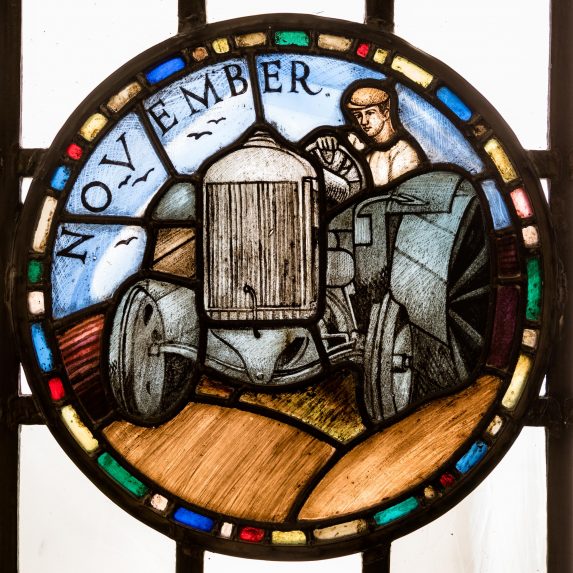Suffolk House, Bury St Edmunds , Suffolk
Address
Suffolk House, 7 Angel Hill, Bury Saint Edmunds IP33 1UZRecommended by
Highlight
12 roundels depicting the Labours of the Month in the stairwellArtist, maker and date
Designed by E M Dinkel and made at Lowndes & Drury, 1937Reason for highlighting
In 1937 Lowndes & Drury were employed to make leaded lights to windows and swing door in the new municipal offices and clinic. They also installed 12 roundels on either side of the staircase at ground and first floor levels, which were designed by Dinkel. These depict the Labours of the Months, some being donated by citizens of the town in memory of their relatives who had been closely associated with the work of the Council.
The Labours of the Months have long been a favourite theme of mine. Medieval artists would depict the work associated with each month and in doing so would give us an insight into the everyday tools, clothes and working methods of their time. These panels from the 1930’s also show the timeless cycle of land work, such as lambing, ploughing and gathering wood for winter fires. And how quaint the vintage tractor, shire horse and shepherd’s smocks look now! The fattened turkey, duck and cockerel in December are delightfully whimsical and harken back to medieval depictions of feasting and warming in winter.
Artist/maker notes
Ernest Michael Dinkel (1894-1983) was a painter, sculptor and designer. He was born in Huddersfield and studied at the local technical college before moving to London to study at the RCA, graduating in 1925. He then taught at the RCA 1925-40 as instructor in mural decoration, afterwards becoming the Head of Stourbridge School of Art 1940-47 and subsequently Head of the School of Design at Edinburgh College of Art 1947-61.
Early on, Dinkel was best known as a painter but during the 1930s he also excelled in decoration and graphic art. He designed some posters for London Underground and was prolific in the expanding field of the painting of inn signs. Dinkel seems to have been only an occasional designer for glass, but he promoted the craft when he headed the Stourbridge School.
Source: Alan Brooks
Lowndes & Drury was formed in 1897, by the artist Mary Lowndes (1857-1929) and the craftsman Alfred John Drury (1868-1940), with the aim of providing facilities for independent artists to design and make stained glass windows. They moved from cramped conditions in Chelsea to newly purpose-built premises, The Glass House, Fulham in 1906. The firm continued after the founders’ deaths, under Alfred Drury’s son, Victor, until he retired in the early 1970s. However, The Glass House premises continued in use under Carl Edwards and subsequently his daughter, Caroline Benyon, until she moved her studio to Hampton in1992.
Source: The Journal of Stained Glass, Vol. XLI, 2017



Other comments
Since selecting the stained glass this building has been converted from public use to a number of mainly private offices. However, one of the tenants, the Bury St Edmunds Registration Office, has kindly agreed to make the glass accessible to visitors if arrangements are made in advance on 01284 732888.